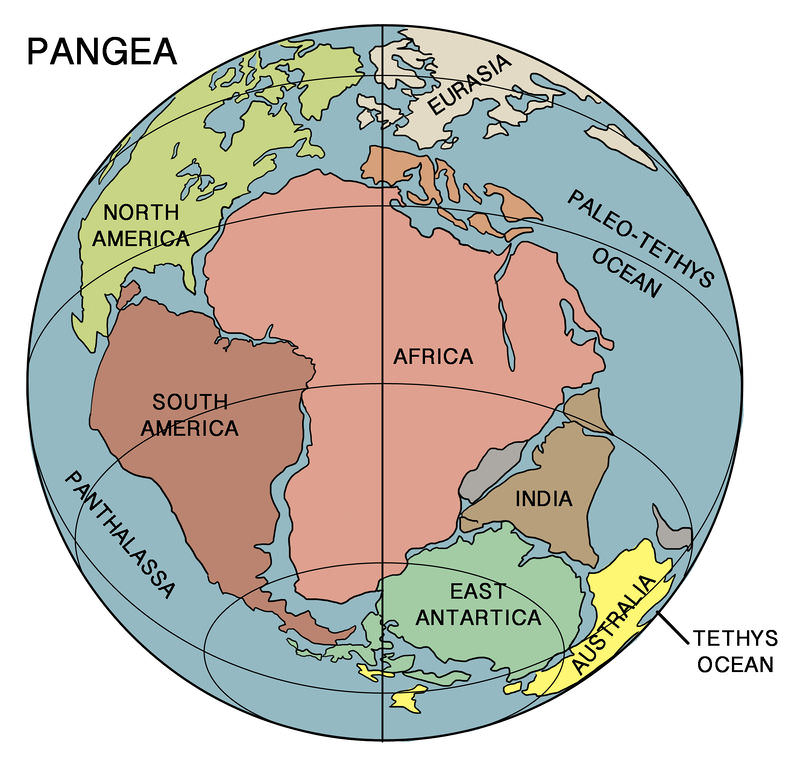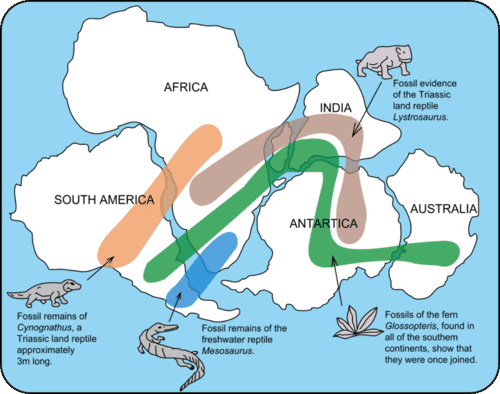READ: Continental Drift
READ: Continental Drift
Why do the continents of Africa and South America appear to fit together so well? Is it an accident that they do, or is there some geological reason?
Wegener’s Idea
Alfred Wegener, born in 1880, was a meteorologist and explorer. In 1911, Wegener found a scientific paper that listed identical plant and animal fossils on opposite sides of the Atlantic Ocean. Intrigued, he then searched for and found other cases of identical fossils on opposite sides of oceans. The explanation put out by the scientists of the day was that land bridges had once stretched between these continents.
Instead, Wegener pondered the way Africa and South America appeared to fit together like puzzle pieces. Other scientists had suggested that Africa and South America had once been joined, but Wegener was the idea’s most dogged supporter. Wegener amassed a tremendous amount of evidence to support his hypothesis that the continents had once been joined.
Wegener’s Evidence
Here is the main evidence that Wegener and his supporters collected for the continental drift hypothesis:
- The continents appear to fit together.
- Ancient fossils of the same species of extinct plants and animals are found in rocks of the same age but are on continents that are now widely separated (figure below). Wegener proposed that the organisms had lived side by side, but that the lands had moved apart after they were dead and fossilized. His critics suggested that the organisms moved over long-gone land bridges, but Wegener thought that the organisms could not have been able to travel across the oceans.
- Fossils of the seed fern Glossopteris were too heavy to be carried so far by wind.
- Mesosaurus was a swimming reptile, but could only swim in fresh water.
- Cynognathus and Lystrosaurus were land reptiles and were unable to swim.
- Identical rocks, of the same type and age, are found on both sides of the Atlantic Ocean. Wegener said the rocks had formed side by side and that the land had since moved apart.
- Mountain ranges with the same rock types, structures, and ages are now on opposite sides of the Atlantic Ocean. The Appalachians of the eastern United States and Canada, for example, are just like mountain ranges in eastern Greenland, Ireland, Great Britain, and Norway (figure below). Wegener concluded that they formed as a single mountain range that was separated as the continents drifted.
The similarities between the Appalachian and the eastern Greenland mountain ranges are evidences for the continental drift hypothesis.
- Grooves and rock deposits left by ancient glaciers are found today on different continents very close to the Equator. This would indicate that the glaciers either formed in the middle of the ocean and/or covered most of the Earth. Today, glaciers only form on land and nearer the poles. Wegener thought that the glaciers were centered over the southern land mass close to the South Pole and the continents moved to their present positions later on.
- Coral reefs and coal-forming swamps are found in tropical and subtropical environments, but ancient coal seams and coral reefs are found in locations where it is much too cold today. Wegener suggested that these creatures were alive in warm climate zones and that the fossils and coal later drifted to new locations on the continents.
- Wegener thought that mountains formed as continents ran into each other. This got around the problem of the leading hypothesis of the day, which was that Earth had been a molten ball that bulked up in spots as it cooled (the problem with this idea was that the mountains should all be the same age and they were known not to be).
- Alfred Wegener did some background reading and made an observation.
- Wegener then asked an important question and set about to answer it.
- He collected a great deal of evidence to support his idea. Wegener’s evidence included the fit of the continents, the distribution of ancient fossils, the placement of similar rocks and structures on the opposite sides of oceans, and indicators of ancient climate found in locations where those climates do not exist today.


